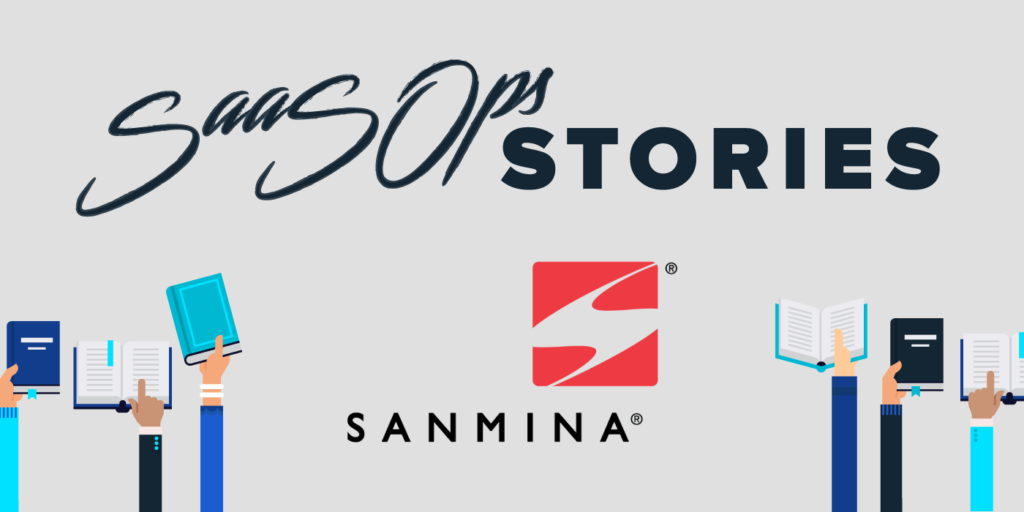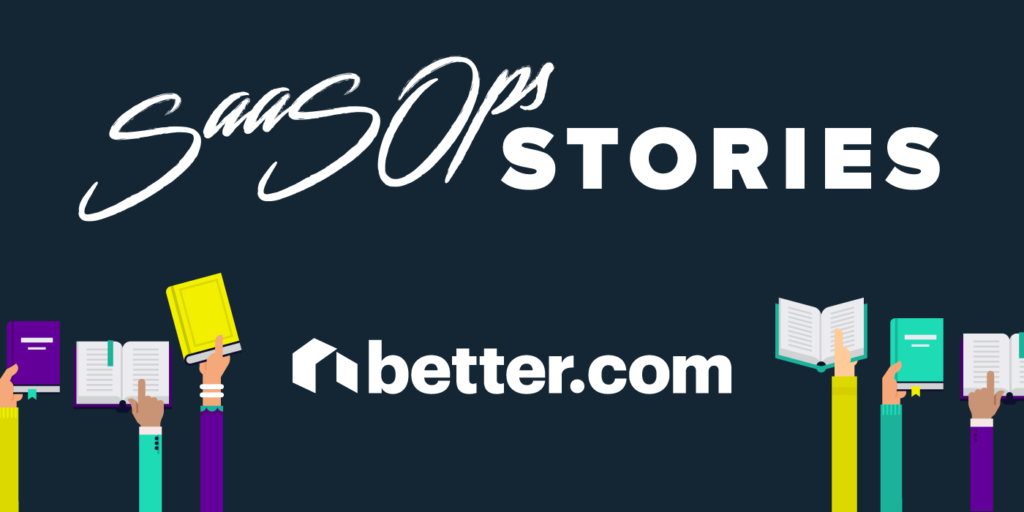SaaSOps Stories With Michael Weir, Director of Operations at Global Payments
September 16, 2020
6 minute read

Michael Weir is a former director of the collaboration operations function at Global Payments, a financial technology services company that has evolved into a global leader in the payments space over the last 53 years. Since beginning his career during the dot-com boom of the late 1990s, Weir has led IT teams at some of the world’s most recognizable companies, including PwC and Aon eSolutions.
As part of a continuing series, our Chief Customer Officer Rachel Orston sat down with Weir for a discussion on the SaaSOps landscape, including how his teams have onboarded new employees after acquisitions and how he’s changed his management style as the current pandemic has led to an uptick in remote work.
Editor’s Note: This conversation has been edited lightly for clarity.
Can you tell me about your role at Global Payments and how you got into your current role?
I was in the infrastructure area and had completed a pretty successful internal project, which we typically had not done well in the past. IT was a black box, so to speak. But we were able to solve some significant business challenges through that initiative and that led to even bigger projects.
We’ve constantly been integrating different systems over the years, researching the best systems for the organization, and have taken advantage of best-of-breed. We inherited a lot of legacy systems and ultimately retired technical debt through merger and acquisition activities. Back in 2017, I was responsible for implementing G Suite across the organization, which helped us improve productivity and save a few million dollars.
I’m really proud of that initiative for two reasons. I received the CEO’s “Circle of Excellence” award for that effort, which was really nice. And then on top of that, I was promoted to lead the operations team. We were in a really aggressive acquisition phase, and so things haven’t been business as usual. Because of our latest acquisitions, we’ve done a variety of migrations and implementations in G Suite. The ongoing challenge of bringing our company together is a lot of fun, especially since we’re acquiring companies on a fairly regular basis.
What lessons have you learned through the acquisitions you’ve made over the years? What would you share with other IT leaders who might be in a similar position?
Setting expectations is always important. When you put new tools in front of people, you need to make sure those products can do the things that end users expect them to do. And you need to make sure they’re ready to make a change. You’ll always find some user groups that aren’t prepared for what’s happening, but it’s your job to ensure that isn’t an organization-wide problem. It’s critical to let everyone know what you’re doing, why you’re doing it, and then executing on your plan cleanly to build confidence in what you’re delivering.
You can’t skip even the simplest things. There are some nuances to items such as Google. One of the best use cases is when you take a shared mailbox out of Outlook and move them to something that’s much more dynamic and feature-rich, such as Google Groups. You need to give them the tools to be successful, and not just the “how-to” guide. You also need to provide examples of other business areas that have made that switch and the lessons they learned.
Change is hard for lots of folks, especially when you’re part of the company that’s being acquired. Have you done things that have gone beyond making people feel comfortable and get them excited?
Actually, I’ve found that people get excited because they’re coming on board with the so-called “mothership.”
But no matter the case, if you put a better product in front of someone that allows them to collaborate with more of their colleagues, they’re going to embrace it.
I’ve had people banging on my door to get changes implemented faster; it’s somewhat rare that someone comes to me and complains that their cheese was moved.
That’s great. You mentioned that IT historically was viewed as a black box. How do you think organizations view IT today? And in your eyes, what is its purpose?
When I began my career 20 years ago, there was an opposite paradigm to what you have today. If you were a new IT professional in the early 2000s, it was hard to find the financial means to get the type of computer you had at work for your home office. Back then, most people understood those limitations. That has flipped over the last few years, and IT is viewed as a barrier because there are so many amazing tools that people can choose from—and they’re all incredibly accessible.
Considering how many people are working remotely today, it’s our responsibility to give employees the tools that align with what they can go out and get themselves. We’re really proud that we’ve moved to a suite of applications where many of the controls they’re used to dealing with from a corporate standpoint are behind the scenes. There’s a really positive relationship between both sides, but that also comes with higher expectations. For instance, suddenly everyone has unlimited mailbox storage and a cloud-based system that’s unlimited in scale and scope. Now we have to help them with those expectations in mind.
Do you feel that the pandemic has accelerated some initiatives that were already underway, or did it present other challenges that you couldn’t anticipate?
So I think the answer to that is expectations have been raised as a result of the pandemic. If you look at Zoom and all the other conferencing tools, everyone is constantly using them and comparing one to another. So we have to have an open dialogue with our providers that the bar has been raised by our users—and as a result, our needs as a business have changed.
The one thing that’s been somewhat pleasant is that our users have given us a little bit of a pass working remotely. There’s been a little bit more patience with our team during this period of time, which has enabled us to execute more quickly and at a lower cost. Most people are reasonable. But when it comes to the tools and platforms they have out there, they’re holding us to a higher standard to choose the best ones.
Has that raised the pressure on your team to excel? And what have you done to take that pressure off of them or keep them motivated?
Like many companies, we’ve had to learn how to do more with less. Everyone has been impacted as a result of the pandemic. There have been some good opportunities when it comes to certain industries, but you’ve seen a real contraction of the economy. But IT’s role has evolved; we’re helping our companies become more efficient.
That’s part of the mission that we have; if we get more employees to use more of the tools we’ve provided, it creates a better experience for everyone. Not only that, but it makes things cheaper for us, and my team’s primary goals have been to keep everyone productive while paying close attention to the company’s bottom line.
When we get to the other side of this, where do you want to see that innovation and that productivity continue? Where do you think success looks like for your team and for Global Payments?
I think there are really two trends. First, adopting more cloud-specific things like SaaSOps and leveraging BetterCloud to handle tools more efficiently.
That means more automation, which helps us set expectations with our users and ultimately makes us more efficient. BetterCloud is a huge key to what we want to do on that front.
The other item that I see is that more companies are starting to hire remote candidates. That really opens up the talent pool, which is an obvious benefit to companies. But on the other hand, I think the challenge there is that you’re going to see more folks struggle with the concept of work-life balance.
When we wrap up here, I might have to help my daughter with Common Core math. There are a lot of people dealing with similar challenges, or even bigger ones at home. How is that impacting me, and how is that affecting my staff? I can’t see body language any more or how they’re reacting to things. So I think ensuring the wellbeing of our employees is going to be a huge challenge, even though I feel remote work is ultimately going to enable companies to be successful in the future.
You’ve been remote for some time, and you’ve been very successful growing your career in a remote environment. Do you have any advice that has really helped you balance being a father and a strong leader for your team?
It’s really important to set reasonable boundaries. And that’s not just a negative boundary with your company saying, “Hey, I’m off duty at this time.” You also need to set boundaries with the people that are at home with you all day. Of course, that doesn’t mean creating an invisible wall and not seeing your child during the day. But you need to set expectations with everyone you interact with during the day.
The other item, especially if you work globally, is to clearly communicate when you’re working. I have staff all over the world. We’ve created a visible calendar to help us understand when each person is available. That’s really important for work-life balance. It helps us keep people from burning themselves out, and it makes up for the fact that we can’t just go into a cube farm and see which lights are on.
That’s super interesting. I’ll leave you with one final question: When we’re through this pandemic, what’s one of the first things you’d like to do?
I really enjoy traveling with my team and seeing my customers. I like being able to walk in their shoes a little bit. I think that perspective is a huge benefit to me as a leader, so I definitely miss visiting with my staff and customers, even if it’s on a casual basis. I’m looking forward to traveling again without being nervous about it.
Want more insights from other IT leaders on navigating the new normal? Check out Orston’s previous conversation with Craig Holland, SVP of global infrastructure at Condé Nast.
Have a story you’d like to share with us? Send us an email here.






